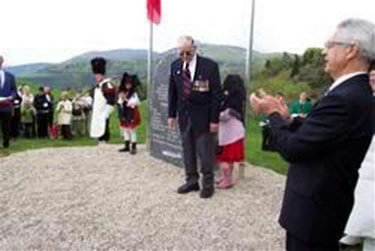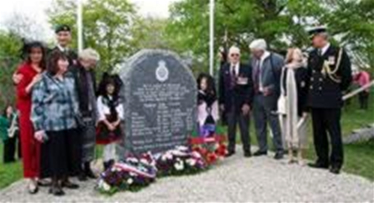© Dernières Nouvelles D'alsace, Vendredi 05 Mai 2006.
Tous droits de reproduction réservés
A monument on Freundstein
Mr. Lorne Mallory, at the right side of the monument, with family and officials. (Photo DNA) |
|
own territory. One of the bombardment missions was to end quite brutally during the night of 2-3 December 1944 at the Freudstein site, above Willer-sur-
Thur, for Canadian Halifax bomber MZ-807, hit by German flak; the bomber - manned by a seven-member crew – failed to return to its
base in England after having bombed Hagen, in the Ruhr. The plane headed to the south (after its bombing run) and attempted
an emergency landing in the hilly area beyond the farm-auberge of Freundstein. After having smashed into trees, the plane caught fire. In
the catastrophe, one single survivor, Lorne Albert Mallory, was rescued and cared for by several families of Willer; he returned from Canada to
inaugurate the monument erected to the memory of the courageous aviators.
Their story has been reconstructed due to the research of the
Association of Friends of Aviation History in Alsace.
An inauguration ceremony rich in emotion allowed the paying of
homage to these young combattents from far-away Canada who
contributed to our liberation. Joined by actual participants and
witnesses of this event of the war, officials and participants in the
ceremony fulfilled their duty to remember this sacrifice for our liberty.
A monument at Freundstein

Mr. Lorne Mallory, guest of honour. (Photo DNA)
“Corkscrew Charlie” was the code name of the Canadian Halifax bomber MZ-807 that took part at the start of December 1944 in the bombing mission in the Ruhr. The sole survivor of the crash was a Canadian who took part in the inauguration of a monument to the
memory of his six comrades. This was to be, unfortunately, the last mission of the bomber. The operation aimed at destroying the industrial installations of the village of Hagen, a strategic node situated a little south of Essen and Dortmund, required the engagement of 504 planes, of which almost 180 consisted of Anglo-Canadian crews. For Halifax MZ-807 “Corkscrew Charlie,” the flight begun at 17:00 from Skipton-on-Swale, between Leeds and Manchester, would not be followed by a return.
A desperate maneuver above the Riesenkopf After dropping its bombs on the target, about 21:00, the plane made for the south, for reasons unknown. The most plausible reason is damage (to the aircraft) caused by German ground defenses or by a German night-fighter. In any event, the bomber headed towards Alsace - towards the south - in the direction of territory already liberated from the Nazi occupiers. However, the damage (fire) to the plane could not be overcome, and the pilot of the plane attempted a
desperate maneuver to land in the hills of Freundstein, at 925 m
altitude and by some distance above the farm-auberge.
The calendar records that, on 2 December at 23:00, the bomber struck
the hill and tore itself apart in the forest. Of the seven crew members,
six were lost in the fire that followed the crash. Surviving miraculously,
but seriously burned, mid-upper gunner Lorne Albert Mallory was
rescued and taken the next day by the owner of the farm-auberge (to
the farm), then taken to Willer-sur-Thur, where he was housed and
cared for by several families despite the danger represented by the
occupiers, continuously present since the start of December. After the
liberation of the village on 8 December, the Canadian aviator was
transported to the American hospital at Neuilly, then transferred a
little later to England, before returning to Canada by ship at the end of
February 1945.
His crew mates, interred initially in a communal grave at the site, have
rested since 1950 in a cemetery of the Royal Canadian Air Force at
Choloy, beside Toul, after having been interred provisionally at a
military cemetary of the French forces.
Multiple research into the crash
History has stood still during the decades since the crash. Under the
encouragement of the Association of Friends of Aviation History in
Alsace, the crash at Freundstein has come to light, particularly based
on testimony quoting a survivor among the crew. The association,
presided over by Jean-Marie Deharvengt, applied itself to research into
different materials of the crash site, and into people of the Toronto
region in order to reconstruct what happened. The community of
Willer-sur-Thur, near Freundstein, when presented with the results of
this research, immediately took upon itself the responsibility to effect a
monument to these victims, which is itself the result of several years
of collaboration between the various interested parts.
This Sunday, May 7, will constitute one strong moment in the patriotic
festivities. Mr Lorne Mallory, accompanied by his wife Constance and
members of his family, came to inaugurate the monument set up by
the municipality on the road to Freundstein, a few hundred meters
from the place of the crash landing. After a memorial mass celebrated
in the Saint-Didier church by the abbot Vincent Fluhry and supported
by the participation of the professional québecquoise soprano singer
Louise Dumontier and the municipal band, three buses transported the
participants, nearly 150 in total, to the site chosen for the monument.The names of the six victims and of the survivor
In the presence of Commander (N) Claude Gautier, defense attaché of
the embassy of Canada, of Martine Diffor, regional councilman, Michel
Habib, general councilman, and of Colonel (Fr) Jean-Jacques Borel,
commander of French airforce base BA 132 and military
representative, mayor Alain Delestan and his honoured guests
unveiled the monument displaying the names of the six victims of the
crash and of the survivor who rest evermore in memory. A detachment
from the airforce base at Meyenheim displayed the honors (i.e.
Provided a guard of honour) while a “Variez” ultralight aircraft based in
Colmar made gracious arabesques in the sky. After the ceremony, the
municipal band of Willer played the national anthems of Canada and
France.
The remarks of the guest speakers pointed out the importance of the
duty of memory towards the future generations; Mr. Mallory himself
was pleased with the presence of so many young people at the site of
the commemoration, guaranteeing perpetuation of the memory of
sacrifice.
The protocol of the ceremony was completed by the inauguration in
the main room of the town hall of Willer of an exhibition devoted to the
crash landing of the Canadian bomber. Explanatory tables and displays
gathering parts of the plane illustrated this tragic episode of the final
phase of the Second World War. In this day (7 May) before the
commemoration of the Armistice of 1945, it was a beautiful day to
remember.
P. Rudler
Cordialement,
M. Landaret / abonnement.internet@dna.fr
